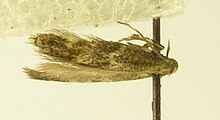Species of moth
| Elachista canapennella
|
![]()
|

|
Scientific classification 
|
| Domain:
|
Eukaryota
|
| Kingdom:
|
Animalia
|
| Phylum:
|
Arthropoda
|
| Class:
|
Insecta
|
| Order:
|
Lepidoptera
|
| Family:
|
Elachistidae
|
| Genus:
|
Elachista
|
| Species:
|
E. canapennella
|
| Binomial name
|
Elachista canapennella
|
| Synonyms
|
-
- Tinea canapennella Hübner, 1813
- Tinea pulchella Haworth, 1828
- Elachista pulchella (Haworth, 1828)
- Poeciloptilia obscurella Stainton, 1849
- Poeciloptilia incanella Herrich-Schäffer, 1855
- Elachista incanella (Herrich-Schäffer, 1855)
- Elachista subobscurella Doubleday, 1859
- Poeciloptilia montanella Wocke, 1862
- Elachista ranenensis Strand, 1919
- Elachista albimarginella Hering, 1924
- Elachista postremella Dufrane, 1957
|
Elachista canapennella is a moth of the family Elachistidae found in Europe.
Description
The wingspan is 8–10 millimetres (0.31–0.39 in).[1]
The head is grey, face whitish. Forewings in male pale grey irrorated with black, in female blackish except on basal area; a somewhat oblique fascia before middle, a tornal spot, and
triangular costal spot somewhat beyond it in male very indistinct, whitish, almost obsolete, in female broader, white, conspicuous. Hindwings are grey. The larva is pale yellowish-grey; head pale brown.[2]
Adults are on wing from April to June and from July to September. There are two generations per year.
The larvae feed on creeping bent (Agrostis stolonifera), false oat-grass (Arrhenatherum elatius), Avenula pubescens, tufted hairgrass (Deschampsia cespitosa), fescue (Festuca species), creeping soft grass (Holcus mollis) and meadow-grass (Poa). They mine the leaves of their host. The pupation takes place outside the mine.[3]
Distribution
It is found from Fennoscandia and northern Russia to the Pyrenees, Italy and Romania and from Ireland to central Russia.[3]
References
External links